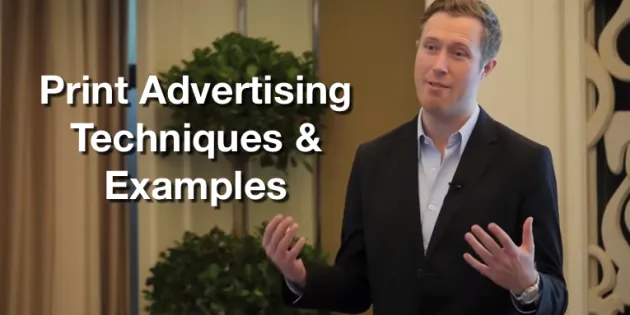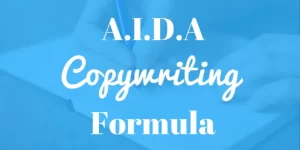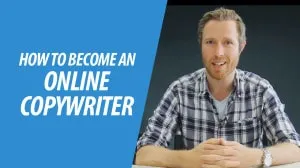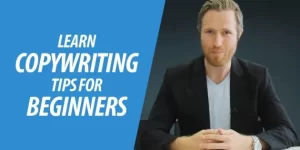Hi this is Jesse from StartCopywriting.com and in this video I\’m going to share with you some Print Advertising Techniques and Examples that you can apply when writing print ads. I’m going to analyse a successful print ad and point out the elements that make it work.
In this article you’ll learn how to:
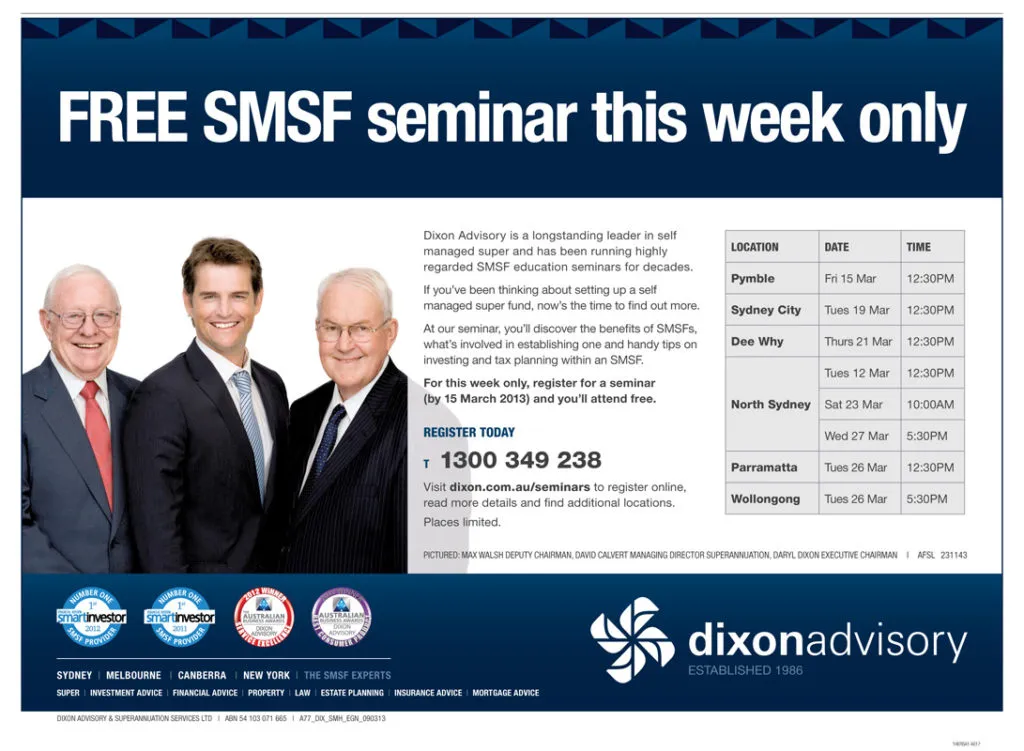 You’ll notice in the free SMSF consultation Ad, they have scarcity and also they have an effective call to action. Too many print ads don’t have either. There’s no reason for me to call and act now, or take action now; there’s no reason for that scarcity or urgency. There’s also no effective call to action, or there might not even be a call to action at all. They leave that out and just assume if they show their ad enough times, certainly people will know what they need to do.
You need to instruct people what to do. Remember, we are drowning in information. We have a short attention span. We need to know what to do, so don’t make it difficult by assuming people will find you. Tell them what to do.
The above image is an example of an ad that’s run every single week in Australia. I’ve looked at the results behind it and it’s doing very, very well. If you look at the headline, it’s got a compelling offer. If you’re someone who’s after self-managed superfunds, this is a free SMSF consultation.
It’s for one week only, so we’ve got that urgency in there, and then we’ve got the call to action: book now. Now not every offline print ad needs to have these elements, but notice how it’s a compelling, I-better-read-this-now headline.
Look at the first paragraph:
You’ll notice in the free SMSF consultation Ad, they have scarcity and also they have an effective call to action. Too many print ads don’t have either. There’s no reason for me to call and act now, or take action now; there’s no reason for that scarcity or urgency. There’s also no effective call to action, or there might not even be a call to action at all. They leave that out and just assume if they show their ad enough times, certainly people will know what they need to do.
You need to instruct people what to do. Remember, we are drowning in information. We have a short attention span. We need to know what to do, so don’t make it difficult by assuming people will find you. Tell them what to do.
The above image is an example of an ad that’s run every single week in Australia. I’ve looked at the results behind it and it’s doing very, very well. If you look at the headline, it’s got a compelling offer. If you’re someone who’s after self-managed superfunds, this is a free SMSF consultation.
It’s for one week only, so we’ve got that urgency in there, and then we’ve got the call to action: book now. Now not every offline print ad needs to have these elements, but notice how it’s a compelling, I-better-read-this-now headline.
Look at the first paragraph:
 I hope you learned some great tips in this video. And if you have any thoughts on this video and article about Print Advertising Techniques and Examples, don’t forget to leave your comments below!
I hope you learned some great tips in this video. And if you have any thoughts on this video and article about Print Advertising Techniques and Examples, don’t forget to leave your comments below!
- Write an attention grabbing headline
- Identify who the message is for
- Choose the right image
- Include scarcity or reason to act now
- And include an effective call to action
Attention grabbing headline
Your print ad, direct mail or any other printed advertising, needs to have a headline. You want to write an engaging headline that’s going to grab the attention of your target audience.Identify who the message is for
You should always point out who the message is for early on in the copy, and I usually do that by asking questions that my ideal prospect is going to relate to. So those first two steps with the headline and the opening sentence or opening paragraph should be written exclusively for your target audience. There’s a mistake people make in advertising in that they think their product is so great, so useful, and everyone should own it. So they end up writing bland and generic copy that’s trying to get everybody’s attention because they think everybody is their target market. That’s a huge waste of time and money. I think when you say everyone is your target market, it means your copy is going to be so generic, bland, it’s actually going to appeal to nobody, and that’s a big mistake.Choose the right image
Not every image is going to be appropriate for your market but you want to have an image that’s going to capture their attention just like what you see in offline media such as in newspapers or magazines. Typically, it’s an engaging, action-orientated image, or it’s a professional image you’ll see in these cases.Include scarcity with an effective Call To Action
 You’ll notice in the free SMSF consultation Ad, they have scarcity and also they have an effective call to action. Too many print ads don’t have either. There’s no reason for me to call and act now, or take action now; there’s no reason for that scarcity or urgency. There’s also no effective call to action, or there might not even be a call to action at all. They leave that out and just assume if they show their ad enough times, certainly people will know what they need to do.
You need to instruct people what to do. Remember, we are drowning in information. We have a short attention span. We need to know what to do, so don’t make it difficult by assuming people will find you. Tell them what to do.
The above image is an example of an ad that’s run every single week in Australia. I’ve looked at the results behind it and it’s doing very, very well. If you look at the headline, it’s got a compelling offer. If you’re someone who’s after self-managed superfunds, this is a free SMSF consultation.
It’s for one week only, so we’ve got that urgency in there, and then we’ve got the call to action: book now. Now not every offline print ad needs to have these elements, but notice how it’s a compelling, I-better-read-this-now headline.
Look at the first paragraph:
You’ll notice in the free SMSF consultation Ad, they have scarcity and also they have an effective call to action. Too many print ads don’t have either. There’s no reason for me to call and act now, or take action now; there’s no reason for that scarcity or urgency. There’s also no effective call to action, or there might not even be a call to action at all. They leave that out and just assume if they show their ad enough times, certainly people will know what they need to do.
You need to instruct people what to do. Remember, we are drowning in information. We have a short attention span. We need to know what to do, so don’t make it difficult by assuming people will find you. Tell them what to do.
The above image is an example of an ad that’s run every single week in Australia. I’ve looked at the results behind it and it’s doing very, very well. If you look at the headline, it’s got a compelling offer. If you’re someone who’s after self-managed superfunds, this is a free SMSF consultation.
It’s for one week only, so we’ve got that urgency in there, and then we’ve got the call to action: book now. Now not every offline print ad needs to have these elements, but notice how it’s a compelling, I-better-read-this-now headline.
Look at the first paragraph:
Thinking about setting up a self-managed super fund?They’re not asking a question that appeals to everyone’s needs. They are asking something which appeals directly to the ideal prospect. Basically, that’s how you should always start off. Typically a lot of my copy, both online and offline, asks those questions to identify and get the prospect to say, “Yes, this is me”. You want them, as they read it, to be nodding their head in agreement. You can do that for any business: you know what their problems are, and you’re going to ask what they are in the copy. So you’re calling out to your ideal target market. Then in the next paragraph they talk about their credibility and establish themselves as an authority. This is called understanding your prospect’s pain and then agitating it. You’ve got to know what their pain is:
- What are they going through?
- What are they having problems with?
- Do you have this problem?
- It must be terrible to have this problem…
It’s difficult to know which one to choose, so you should probably get some expert advice.Whilst subtly hinting that they’re going to be providing that advice. But they’re agitating the prospect’s problem by pointing it out. They have already established credibility, before listing their call to action: “do this before this date, and you’ll get this”. So it’s an effective call to action copy. Notice that it’s not pushy and it’s not hard-sell.
>> Learn 6 Landing Page Copywriting Tips <<
Qualify the reader
They go on to qualify the reader:If you’re in this situation, and you have this amount of money, then this is perfect for you.So they don’t want calls from everyone or people who aren’t their ideal prospect. In this piece of copy they’re saying, “are you in this situation? Do you have these problems? If so, you want to contact us for this free consultation.” It’s a great way of qualifying your audience. How many have you have got leads before which were just a waste of time? You can qualify online and offline people by stating who you’re after in your advertising.
Establish authority and credibility
They end with “but hurry, this offer is for this week only”, and then they have in big, bold lettering their phone number and email address. Notice at the bottom of the ad they’ve got more credibility indicators. If this was a print ad in the newspaper, you don’t know who these guys are and you’ve probably never heard of them. But the image of them speaks authority because they are older gentlemen in suits and they have their names there too. Also, they have a younger man in the photo and that can speak to a younger audience who might be in this situation. Then as you can see below they’ve also got their different offices, again more credibility, and their various certifications. I hope you learned some great tips in this video. And if you have any thoughts on this video and article about Print Advertising Techniques and Examples, don’t forget to leave your comments below!
I hope you learned some great tips in this video. And if you have any thoughts on this video and article about Print Advertising Techniques and Examples, don’t forget to leave your comments below! Share this post!

About Jesse
Hi, I’m Jesse Forrest! As an 18-year freelance writing veteran, I’ve worked with clients in over 153 industries, covering almost every topic imaginable. Passionate about helping others break into freelance writing, I’ve trained over 35,000 people, including teams at Chanel, Disney, and Sony. For the past 6 years, I’ve traveled the world with my trusty laptop, currently residing in Thailand. To kickstart your freelance writing career, download my free guide:

